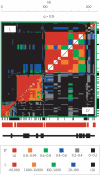Linkage disequilibrium--understanding the evolutionary past and mapping the medical future
- PMID: 18427557
- PMCID: PMC5124487
- DOI: 10.1038/nrg2361
Linkage disequilibrium--understanding the evolutionary past and mapping the medical future
Abstract
Linkage disequilibrium--the nonrandom association of alleles at different loci--is a sensitive indicator of the population genetic forces that structure a genome. Because of the explosive growth of methods for assessing genetic variation at a fine scale, evolutionary biologists and human geneticists are increasingly exploiting linkage disequilibrium in order to understand past evolutionary and demographic events, to map genes that are associated with quantitative characters and inherited diseases, and to understand the joint evolution of linked sets of genes. This article introduces linkage disequilibrium, reviews the population genetic processes that affect it and describes some of its uses. At present, linkage disequilibrium is used much more extensively in the study of humans than in non-humans, but that is changing as technological advances make extensive genomic studies feasible in other species.
Figures

References
-
- Lewontin RC, Kojima K. The evolutionary dynamics of complex polymorphisms. Evolution. 1960;14:458–472.
-
- Weir BS. Genetic Data Analysis II. Sinauer Assoc; Sunderland, Massachusetts: 1996.
-
- Abecasis GR, Cookson WOC. GOLD — Graphical Overview of Linkage Disequilibrium. Bioinformatics. 2000;16:182–183. - PubMed
-
- Zhao H, Nettleton D, Dekkers JCM. Evaluation of linkage disequilibrium measures between multi-allelic markers as predictors of linkage disequilibrium between single nucleotide polymorphisms. Genet. Res. 2007;89:1–6. - PubMed
Publication types
MeSH terms
Grants and funding
LinkOut - more resources
Full Text Sources
Other Literature Sources
Miscellaneous

